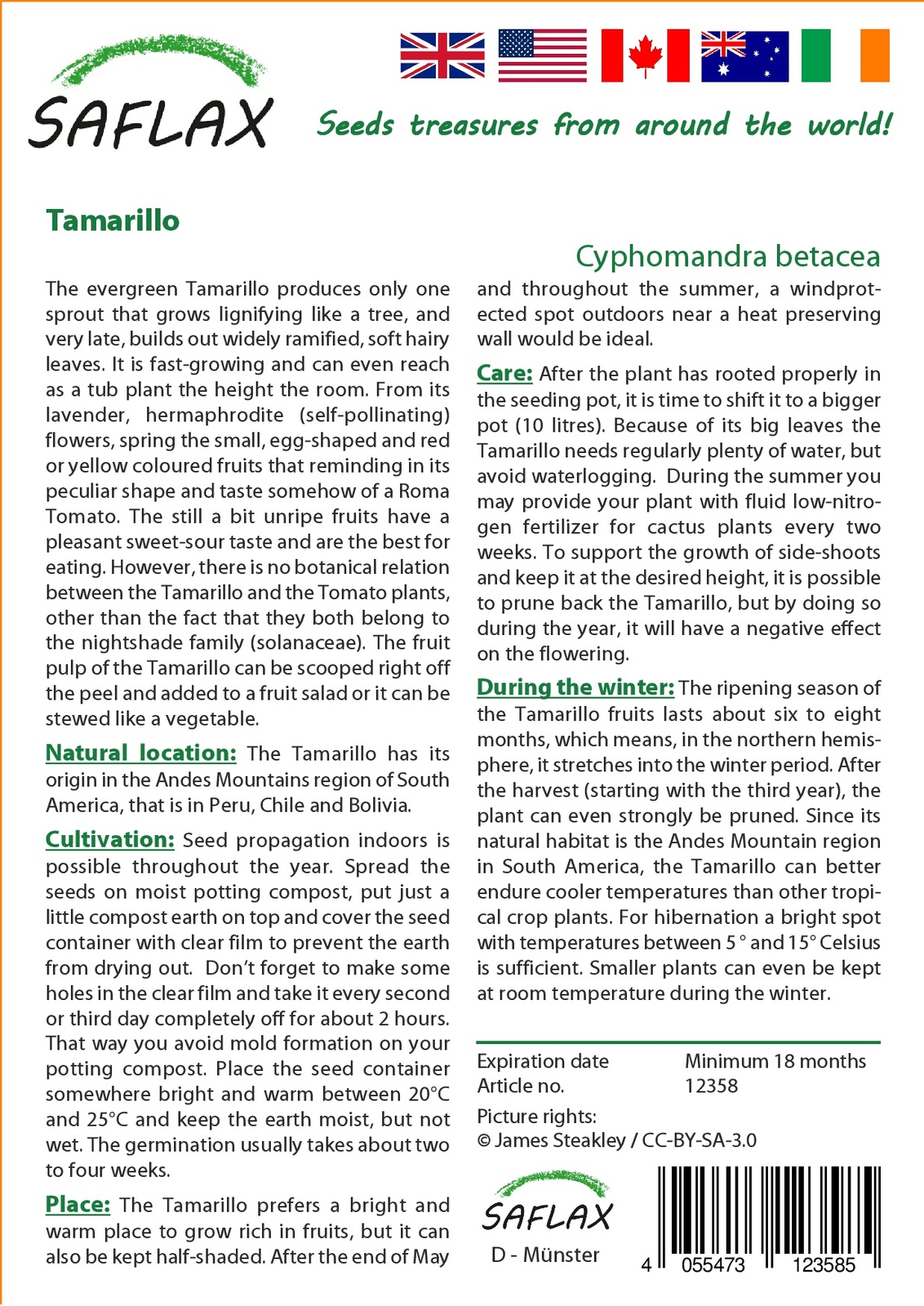SAFLAX Gift Set - Tamarillo - Cyphomandra - and similar items
SAFLAX Gift Set - Tamarillo - Cyphomandra - 50 seeds
$8.35
View full item details »
Shipping options
Return policy
Full refund available within 30 days
Purchase protection
Payment options
PayPal accepted
PayPal Credit accepted
Venmo accepted
PayPal, MasterCard, Visa, Discover, and American Express accepted
Maestro accepted
Amazon Pay accepted
Nuvei accepted
View full item details »
Shipping options
Return policy
Full refund available within 30 days
Purchase protection
Payment options
PayPal accepted
PayPal Credit accepted
Venmo accepted
PayPal, MasterCard, Visa, Discover, and American Express accepted
Maestro accepted
Amazon Pay accepted
Nuvei accepted
Item traits
| Category: | |
|---|---|
| Quantity Available: |
1000 in stock |
| Condition: |
New |
| UPC: |
4055473423586 |
| Country/Region of Manufacture: |
Germany |
| Brand: |
SAFLAX |
Listing details
| Shipping discount: |
Items after first shipped at flat $0.00 | Free shipping on orders over $35.00 |
|---|---|
| Price discount: |
10% off w/ $20.00 spent |
| Posted for sale: |
More than a week ago |
| Item number: |
724195515 |
Item description
SAFLAX Gift Set - Tamarillo - Cyphomandra betacea - 50 seeds - With gift box, card, label and potting substrate
Beautiful summer blossoming and tomato-like fruits in winter
Mail a growing gift to a friend. Coming with the seeds you chose, a little box (17 x 12 x 2 cm) ready to mail, sticker to label the box, greeting card for your personal notes and germfree and permeable potting substrate based on coconut fiber (dried block) in a stand-up bag. This way your friend will be ready to start right away when your gift arrives.
The evergreen Tamarillo produces only one sprout that grows lignifying like a tree, and very late, builds out widely ramified, soft hairy leaves. It is fast-growing and can even reach as a tub plant the height the room. From its lavender, hermaphrodite (self-pollinating) flowers, spring the small, egg-shaped and red or yellow coloured fruits that reminding in its peculiar shape and taste somehow of a Roma Tomato. The still a bit unripe fruits have a pleasant sweet-sour taste and are the best for eating. However, there is no botanical relation between the Tamarillo and the Tomato plants, other than the fact that they both belong to the nightshade family (solanaceae). The fruit pulp of the Tamarillo can be scooped right off the peel and added to a fruit salad or it can be stewed like a vegetable.
Natural Location: The Tamarillo has its origin in the Andes Mountains region of South America, that is in Peru, Chile and Bolivia.
Cultivation: Seed propagation indoors is possible throughout the year. Spread the seeds on moist potting compost, put just a little compost earth on top and cover the seed container with clear film to prevent the earth from drying out. Dont forget to make some holes in the clear film and take it every second or third day completely off for about 2 hours. That way you avoid mold formation on your potting compost. Place the seed container somewhere bright and warm between 20C and 25C and keep the earth moist, but not wet. The germination usually takes about two to four weeks.
Place: The Tamarillo prefers a bright and warm place to grow rich in fruits, but it can also be kept half-shaded. After the end of May and throughout the summer, a wind-protected spot outdoors near a heat preserving wall would be ideal.
Care: After the plant has rooted properly in the seeding pot, it is time to shift it to a bigger pot (10 litres). Because of its big leaves the Tamarillo needs regularly plenty of water, but avoid waterlogging. During the summer you may provide your plant with fluid low-nitrogen fertilizer for cactus plants every two weeks. To support the growth of side-shoots and keep it at the desired height, it is possible to prune back the Tamarillo, but by doing so during the year, it will have a negative effect on the flowering.
During Winter: The ripening season of the Tamarillo fruits lasts about six to eight months, which means, in the northern hemisphere, it stretches into the winter period. After the harvest (starting with the third year), the plant can even strongly be pruned. Since its natural habitat is the Andes Mountain region in South America, the Tamarillo can better endure cooler temperatures than other tropical crop plants. For hibernation a bright spot with temperatures between 5 and 15 Celsius is sufficient. Smaller plants can even be kept at room temperature during the winter.
Bonsai ability: No
Picture credits:
Because of technical limitations links to picture rights are written as text.
42358-cyphomandra-betacea-K-VS-A.jpg - Frank Laue - Saflax - saflax.de/copyright
12403-geschenk-gift-cadeau-regalo.jpg - Frank Laue - Saflax - saflax.de/copyright
12358-cyphomandra-betacea-K-RS-A.jpg - Frank Laue - Saflax - saflax.de/copyright
12358-32-Cyphomandra-betacea.jpg - Ljuba brank - CC-BY-SA-3.0 - creativecommons.org/licenses/by-sa/3.0
12358-33-Cyphomandra-betacea.jpg - Kurt Stber - CC-BY-SA-3.0 - creativecommons.org/licenses/by-sa/3.0
12358-34-Cyphomandra-betacea.jpg - Dinkum - CC-BY-SA-3.0 - creativecommons.org/licenses/by-sa/3.0
12358-35-Cyphomandra-betacea.jpg - Carstor - CC-BY-SA-3.0 - creativecommons.org/licenses/by-sa/3.0
12358-36-Cyphomandra-betacea.jpg - C T Johansson - CC-BY-SA-3.0 - creativecommons.org/licenses/by-sa/3.0
12358-31-Cyphomandra-betacea.jpg - James Steakley - CC-BY-SA-3.0 - creativecommons.org/licenses/by-sa/3.0
Loading
This item has been added to your cart
 SAFLAX Gift Set - Tamarillo - Cyphomandra - 50 seeds added to cart.
1000 available in stock
SAFLAX Gift Set - Tamarillo - Cyphomandra - 50 seeds added to cart.
1000 available in stock
View Cart or continue shopping.
 Please wait while we finish adding this item to your cart.
Please wait while we finish adding this item to your cart.
Get an item reminder
We'll email you a link to your item now and follow up with a single reminder (if you'd like one). That's it! No spam, no hassle.
Already have an account?
Log in and add this item to your wish list.














